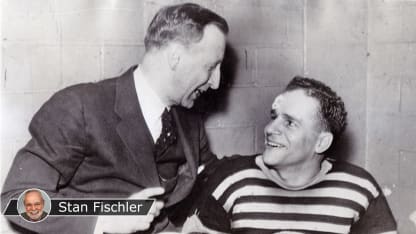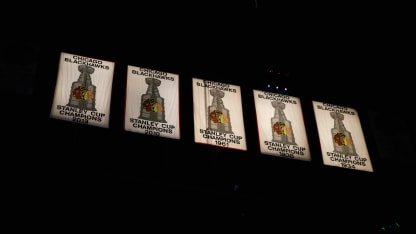If there was a light at the end of the losing tunnel, it was club owner Frederic McLaughlin's decision to build Chicago Stadium. It would be the biggest arena in the NHL, set to be completed during the 1929-30 season.
In the interim, the Blackhawks had to play some games in Detroit and in Fort Erie, Ontario. Yet, it was in that bandbox Canadian arena that Gardiner put on a show for the ages during a game against the Boston Bruins.
It's worth noting that at this point in League history, rules were different. Among them were one-minute penalties for goalies who had to sit in the penalty box.
As it happened, Gardiner executed one of the most unusual saves ever seen after being penalized for tripping Bruins defenseman Eddie Shore behind the Blackhawks net.
While Gardiner sat out his one-minute penalty, teammate Marvin Wentworth moved into the net and exited the moment Gardiner was released. At that moment, Bruins defenseman George Owen shot the puck at the temporarily open net.
It looked like a sure goal, but Gardiner leapt out of the penalty box and somehow made the save.
"The Hawks managed to hold off the Bruins until Gardiner's penalty only had seconds to go," wrote Jack Laing, a reporter from the Buffalo Courier-Express who was covering the game. "Owen got the puck inside the Hawks blue line as Charlie stormed out of the box.
"Then the Bruin took careful aim with his shot. Gardiner, racing over the ice in his heavy, cumbersome pads, leaped into the air like an agile shortstop and caught the puck halfway to the net!"
The Blackhawks had moved into Chicago Stadium in December 1929 and in 1931 reached the Stanley Cup Final for the first time, losing 3-2 in the best-of-5 series against the Montreal Canadiens.
Gardiner won the Vezina Trophy in 1932 and was named to the First NHL All-Star Team.
McLaughlin hired Tommy Gorman to coach the Blackhawks in 1933-34, and with Gardiner playing well enough to win the Vezina for a second time, the Blackhawks finished second in the American Division, seven points behind the Detroit Red Wings.
But those close to Gardiner saw something different about him.
"He suddenly grew more serious," noted one observer. "Instead of relaxing, he kept on shouting to his teammates, more than ever before. He became intolerant of mistakes."
There were many explanations for Gardiner's behavior. It was his seventh season and he could have been tired of being the team's best player.
"Or perhaps," wrote McAllister, "he had a premonition about the future."
Gardiner had been bothered by a tonsil infection but he never missed a game. He started the 1934 Stanley Cup Playoffs by leading the Blackhawks to a quarterfinal-round victory against the Canadiens.
Then in the semifinals Gardiner shut out the Montreal Maroons 3-0 in the first game, and the Blackhawks advanced with a 6-2 goal margin.
The Blackhawks won the first two games of the best-of-5 Stanley Cup Final at Olympia Stadium in Detroit, winning 2-1 in double-overtime in Game 1 and 4-1 in Game 2.
But it had been a struggle for Gardiner who was in pain entering Game 3 at Chicago Stadium. Gorman considered sitting Gardiner, but the goaltender talked his coach into letting him play.
"I want to play," Gardiner said. "Let me play … for the Cup."
The Blackhawks lost 5-2 and Gardiner collapsed on a bench in the locker room after the game.
Gardiner asked one favor from his teammates.
"All I want is one goal next game," he said. "Just one goal and I'll take care of the other guys."
Game 4, on April 10, 1934, was 0-0 entering double-overtime. Gardiner fought through pain and fatigue, until Mush March scored for the Blackhawks at 10:05 of the second overtime.
Gardiner hurled his stick in the air and then barely made it back to the dressing room.
Less than two months later he died in a Winnipeg hospital, having given his life for his Blackhawks.



















